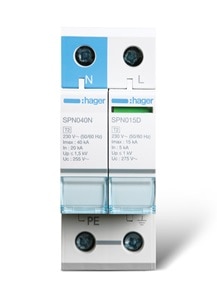Surge Protection
The whole nature of how electrical equipment is used in homes and at work has evolved; with everyday activities relying on electronic equipment.
Products such as computers, printers, televisions, industrial control equipment such as PLC’s, alarms, microwaves and washing machines are common place. These can all be vulnerable to transient overvoltages, which can significantly reduce the equipment’s lifespan through degradation and damage.
A transient overvoltage or surge is a short duration increase in voltage measured between two or more conductors. In short, this means anything from microseconds (millionths of a second) to a few milliseconds (thousandths of a second) in duration.

Surge Protection Devices (SPD's)
SPD’s protect electrical and electronic equipment against transients, originating from lightning, switching of transformers, lighting and motors.
These transients can cause premature ageing of equipment, downtime, or complete destruction of electronic components and materials.
18th Edition Requirements
The 18th edition BS 7671 now stipulates
Protection against transient overvoltages shall be provided where the consequences caused by an overvoltage could
(i) result in serious injury to, or loss of, human life
(ii) failure of a safety service, as defined in Part 2
(iii) significant financial or data loss
For all other cases, protection against transient overvoltages shall be provided unless the owner of the
installation declares it is not required due to any loss or damage being tolerable and they accept the risk of
damage to equipment and any consequential loss.
Selection Criteria
Surge protection devices are classified according to their functions:
Type 1
SPD which can discharge partial lightning current with a typical waveform 10/350 μs. Usually employs spark gap technology.This, if required, will be installed in the primary distribution board at the origin of the electrical installation. A Type 1 SPD does not in itself offer the required protection level and must be used in conjunction with coordinated type 2 devices. An installation with a lightning protection system will require a Type 1 SPD.
Type 2
SPD which can prevent the spread of overvoltages in the electrical installations and protects equipment connected to it. It usually employs metal oxide varistor (MOV) technology and is characterised by an 8/20 μs current wave.This device would normally be in sub-distribution boards and in the primary distribution board if there was no requirement for a type 1 device
Type 3
These SPDs have a low discharge capacity. They must therefore only be installed as a supplement to Type 2 SPD and in the vicinity of sensitive loads. Type 3 SPD’s are characterised by a combination of voltage waves (1.2/50 μs) and current waves (8/20 μs).
Terminology
Iimp – Impulse current of 10/350 μs waveform associated with Type 1 SPD’s
In – Surge current of 8/20 μs waveform associated with Type 2 SPD’s
Up - The residual voltage that is measured across the terminal of the SPD when In is applied
Uc - The maximum voltage which may be continuously applied to the SPD without it conducting.
Maintenance
Most SPDs have an indication window that they are operational. If the indicator is green they are providing protection. If they are red then they have reached ‘end of life’ and will need replacing. Often there is a replaceable cartridge which can simply be withdrawn and replaced with a new operational device.
Frequently Asked Questions:
What does surge protection do?
A surge protection device is designed to protect electrical devices such as computers and TV's from voltage spikes. The surge protection device (SPD) attempts to lessen the voltage supplied to an electrical device by either blocking or shorting to ground any unwanted voltages above a safe standard.
Do you really need surge protection?
If electrical equipment is used then a surge protection device is definitely needed as electrical equipment comes with sensitive components that could be damaged very easily. A surge protection device will increase the longevity of electrical equipment.
How long do surge protectors last?
This will very much depend on how many surges the device will have to deal with, so there is no definitive answer.
The product standard requires the device to cope with a minimum of 15 surges at its rated value. However, a surge at the rated value would be a very large surge indeed. Most events are much smaller than the maximum, but it is these events which degrade sensitive equipment over time. Because the likely surges are smaller than the maximum, it is likely the device will last for many years.
Surge protection devices are equipped with an indication ‘window’ which will turn red when the device has reached its end of life. Usually, it is a simple case of replacing a cartridge at this time. It is recommended this window is checked from time to time especially after a lightning storm.
Can a power surge damage a TV?
Yes, electrical surges have the capacity to overload and short out any electrical equipment in a home, significantly degrading the life of the equipment. Anything that is plugged into a wall can be affected by electrical surges.
More from the 18th Edition
Arc Fault Detection Devices
Arc fault protection devices (AFDD) use microprocessors to identify characteristic current flow and voltage curves that indicate an arc fault and automatically trip the affected circuit.
Selection of RCD Types
RCD's exist in various different forms and react differently depending on the presence of DC components or different frequencies.
Overload Protection
Devices such as switches, RCCBs etc. in distribution boards and consumer units may have historically had their rated current determined after having taken diversity into account but without having considered overload protection of the devices.
BEAMA Guides
A collection of the latest guides relating to 18th Edition, Hager is proud to be a technical contributor to these guides which provide technical advice on a range of 18th Edition related topics.



